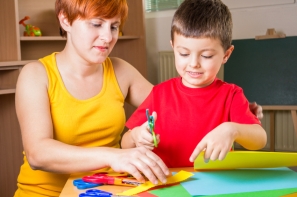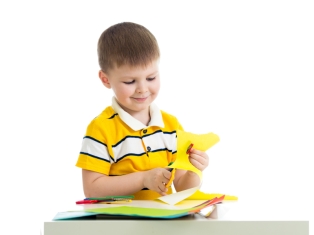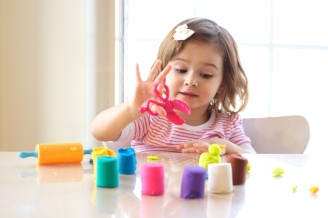Tips for Strengthening Preschool Cutting Skills
by Katie Brazerol
Providers and parents are often nervous about introducing scissors to their children for fear it will encourage cutting things other than paper. (Visions of dolls and younger siblings come to mind). However, if children are allowed to practice using scissors in the correct environment, they are more likely to understand the purpose for scissors while leaving haircuts to the professionals. (It is important, of course, to remind children of appropriate items to cut or not cut.)
Why do children benefit from scissor usage?
Holding scissors uses the same fingers and fine motor muscles as grasping a pencil. The thumb, index finger, and middle finger work together for both skills.
Is correct scissor grasp important?
Yes! Holding scissors the correct way encourages the thumb, index finger, and middle finger to work together just as they would with the correct  pencil grasp. Many children will hold an elbow up and cut in an upside down fashion. Not only is it more difficult for the blades to cut the paper, it also does no good for teaching proper grasp. Help children by placing a small sticker on their cutting thumb. Have them place their thumb through the top hole of the scissors and the middle finger through the other hole, with the index finger resting on the outside of the scissors. If the bottom hole is larger, it is acceptable to place both the index and middle fingers through the bottom hole. As the children cut, the sticker should remain upright and facing them.
pencil grasp. Many children will hold an elbow up and cut in an upside down fashion. Not only is it more difficult for the blades to cut the paper, it also does no good for teaching proper grasp. Help children by placing a small sticker on their cutting thumb. Have them place their thumb through the top hole of the scissors and the middle finger through the other hole, with the index finger resting on the outside of the scissors. If the bottom hole is larger, it is acceptable to place both the index and middle fingers through the bottom hole. As the children cut, the sticker should remain upright and facing them.
Does left or right-handedness really matter?
Yes! There are scissors that are specifically created for left-handed children. The blades are attached differently than right-handed scissors, allowing the child to see his cutting line as he cuts. It is necessary for left-handed children to use and practice cutting with their dominant hand in order to strengthen the muscles needed for writing.
My child can hold scissors…now what?
For a child who is just learning correct scissor grasp, offer paper and demonstrate how to snip around the outside edge. Hold your hand over hers to show her how to open and close the scissors as she snips the lines. You can also help your child practice cutting with training scissors.
Once your child has mastered this task, draw simple lines for her to cut. Finally, draw shapes for her to practice cutting out.
Are scissors only for paper?
Although it is important to stress that children’s scissors should not be used to cut doll or human hair, books, or clothing, there are many materials other than paper that can provide wonderful cutting practice. Try some of the following materials:
- Playdough

- Straws
- Tissue paper
- Crepe paper
- Newspaper
- Index cards
- Yarn
- Tagboard
- Ribbon
To avoid a mess, offer shallow cardboard boxes for children to place the cut materials when they are done. Use the materials to create collages as a great freestyle art project!
Are my children ready to use scissors on their own?
Children who show interest in scissors, even toddlers, can benefit from practicing with them. As long as the child is capable of sitting upright on his own and staying focused on the task, he can begin scissor usage. Before any scissors activity, review the following rules:
- Scissors are sharp. They should be used carefully with an adult present.
- Scissors should only be used while sitting down. Never run with scissors.
- When handing scissors to another person, wrap hand around the closed blades and present the handle to the other person.
- Always ask for permission to use scissors.
- Children should not use scissors to cut hair, books, or clothing. Cut only the art materials provided by an adult.
Back to blog listing